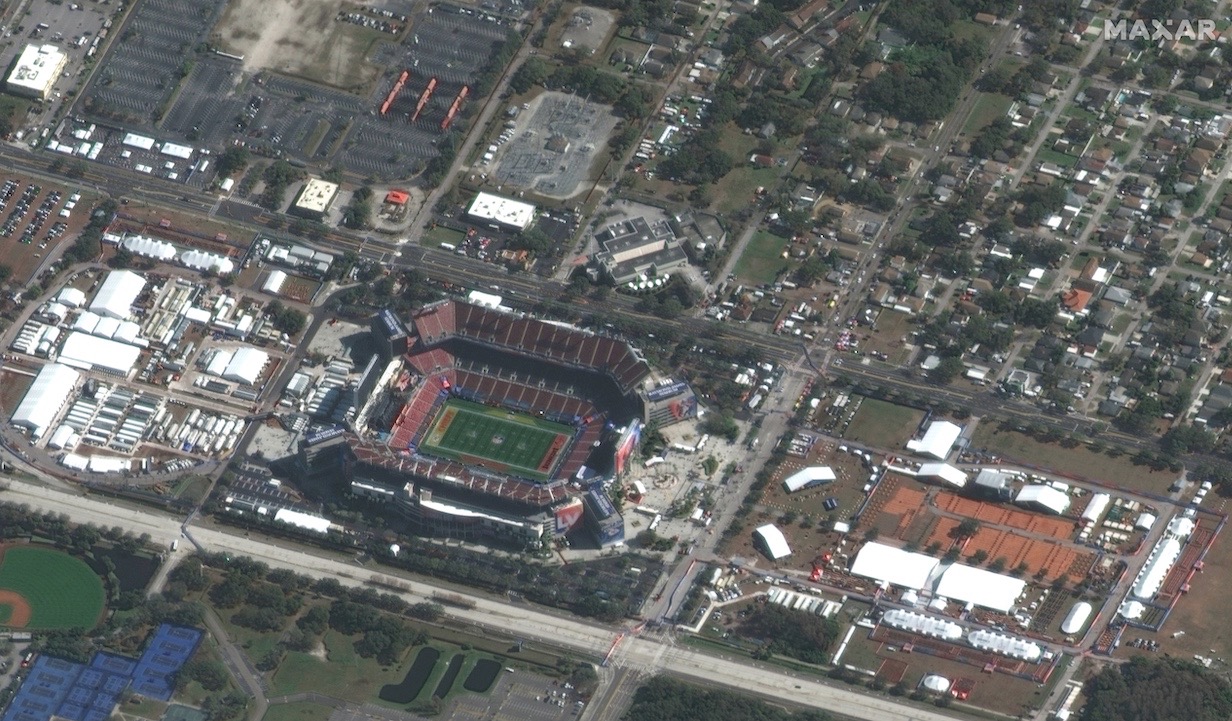
Chiefs fans may want to look away.
Newly released satellite imagery shows Raymond James Stadium in Tampa, Florida, the site of Super Bowl LV. The Tampa Bay Buccaneers won that game decisively yesterday (Feb. 7), beating the Kansas City Chiefs 31-9.
Maxar Technologies' GeoEye-1 satellite snapped the photo yesterday at 11:39 a.m. EST (1639 GMT), about seven hours before kickoff. So the stands were empty and the field clear, allowing good looks at the NFL's shield logo at the 50-yard line and the Chiefs and Buccaneers insignia in the two end zones. (The seats weren't all filled during the game, either; because of COVID protocols, the 66,000-seat stadium hosted just 25,000 fans yesterday.)
Related: International Space Station flies over Super Bowl 2021 stadium

GeoEye-1, which launched in September 2008, zooms around Earth at an average altitude of about 420 miles (675 kilometers). The 4,310-lb. (1,955 kilograms) satellite is capable of resolving features on Earth's surface as small as 16 inches (41 centimeters) wide.
Like many Earth-observation satellites, GeoEye-1 is in a sun-synchronous orbit — a path over Earth's poles that allows views of the planet's surface with consistent solar illumination.
There was some space action during the game yesterday — or during a lull in it, rather. A first-quarter commercial break featured a 30-second ad for an upcoming private spaceflight called Inspiration4, which is led by billionaire tech entrepreneur Jared Isaacman. The ad invited the public to enter two contests to win a seat on Inspiration4, which will launch aboard a SpaceX Crew Dragon capsule later this year.
Get the Space.com Newsletter
Breaking space news, the latest updates on rocket launches, skywatching events and more!
Another commercial, this time for Pringles, pondered what would happen if the tasty chips distracted Mission Control from picking up astronauts who just returned from space.
Mike Wall is the author of "Out There" (Grand Central Publishing, 2018; illustrated by Karl Tate), a book about the search for alien life. Follow him on Twitter @michaeldwall. Follow us on Twitter @Spacedotcom or Facebook.
Join our Space Forums to keep talking space on the latest missions, night sky and more! And if you have a news tip, correction or comment, let us know at: community@space.com.

Michael Wall is a Senior Space Writer with Space.com and joined the team in 2010. He primarily covers exoplanets, spaceflight and military space, but has been known to dabble in the space art beat. His book about the search for alien life, "Out There," was published on Nov. 13, 2018. Before becoming a science writer, Michael worked as a herpetologist and wildlife biologist. He has a Ph.D. in evolutionary biology from the University of Sydney, Australia, a bachelor's degree from the University of Arizona, and a graduate certificate in science writing from the University of California, Santa Cruz. To find out what his latest project is, you can follow Michael on Twitter.









